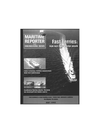
Page 44: of Maritime Reporter Magazine (May 1995)
Read this page in Pdf, Flash or Html5 edition of May 1995 Maritime Reporter Magazine
Taiker Technology:
I* for Halla's shipowning wing, Halla
Merchant Marine.
There has been mounting criti- cism from the world's shipbuilding authorities of this project, but it has been allowed to continue with the blessing of the South Korean Gov- ernment, despite its likely effect upon prices.
Samsung is another expansion- minded newbuilding company. Ear- lier this year the yard's building capacity was supplemented by the extension to an existing building dock to take VLCC tonnage, and now the yard is planning a third
VLCC building dock.
As one of the world's leading tanker builders, South Korea has become involved in ships suitable to meet OPA 90 requirements. All four large shipyards (HHI, SHI, HE&HI and Daewoo) and the smaller Hanjin have designs available and ships on order.
The largest order placed for
VLCCs was by Saudi Arabian-based
Vela Corp., which contracted a se- ries of six 280,000-dwt crude carri- ers from HHI at a price said to be in the region of $114 million each. All the large tankers ordered by Vela and the National Shipping Corp. of
Saudi Arabia from Japan, South
Korea and Denmark have double hull designs. During 1993 HHI won two orders from the Shipping Corp. of India for two double-hulled VLCCs at a cost of $60 million each; Samsung received a similar order. Norwegian owner Peder Smedvig ordered, dur- ing June 1993, two 95,000-dwt crude
Japan and South Korea are the two major shipbuilding nations involved in building VLCCs, although Denmark's Odense
Staalskibsvaerft is also a major player. The only other current or- ders are in Taiwan and Spain, both for domestic owners.
Japan has shown restraint in re- cent years with various government- sponsored initiatives to reduce the number of ships being built in each yard, although very few yards have actually closed for business.
The majority of large Japanese shipyards are involved in the tanker market, all the latest orders includ- ing OPA 90-regulatory double hulls.
The most recent count of orders included Hitachi Zosen (8 large tank- ers), IHI (2), Kawasaki (1),
Mitsubishi (7), Mitsui (1), Sasebo (2) and Sumitomo (2).
Meanwhile, South Korea has ig- nored recent pleas—especially from the OECD — for it to not increase shipbuilding capacity. The main contributors to the South Korean shipbuilding industry are Hyundai
Heavy Industries (HHI), Samsung
Heavy Industries (SHI), Daewoo
Shipbuilding & Engineering and
Hanjin Heavy Industries (formerly
KSEC). New developments include
Halla and Daedong.
The latest development in the
South Korean shipbuilding indus- try is the construction of the large shipbuilding complex at Mokpo, which is being developed by Halla
Engineering & Heavy Industries
Ltd. (HE&HI). The Halla organiza- tion took over the newbuilding and repair yard operated by Inchon
Engineering & Shipbuilding Corp. about two years ago, and since has been successful in various projects including a series of 40,600-dwt product tankers for Shell Interna- tional, the last of which is due for delivery later this year.
Halla, restricted by space to de- velop the Inchon facility, decided that a new building complex should be built at Mokpo, which is a yard capable of building ships up to VLCC size. This new complex, named New
Samho Shipyard, is nearing comple- tion with two suezmax tankers be- ing the first ships due for delivery during the early part of next year.
Recently, the yard won an order for two double-hulled VLCCs to be built at this shipyard. All four ships are 46 Maritime Reporter/Engineering News

 43
43

 45
45
